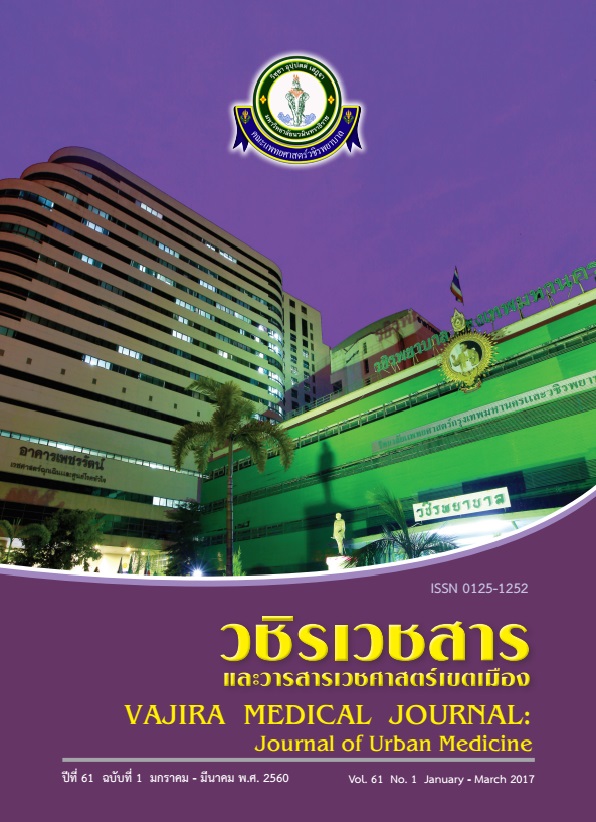A Retrospective Study of Scabietic Medical Workers Exposed to a Norwegian Scabies Patient
Main Article Content
Abstract
Objectives: Scabies is one of the commonest skin disorders in developing world especially in poor, overcrowded tropical areas. The purpose of our study is to provide data of scabietic patients who works in Vajira hospital and had direct contact with Norwegian scabies patient as well as review of the current update on diagnosis and management of scabies.
Methods: We retrospectively reviewed the data of 38 patients who had been exposed to the same Norwegian scabies patient in Vajira hospital and came to Dermatology Unit. The statistical analysis was made by using descriptive statistical analysis. Visual analog scale was used for grading of pruritus.
Results: Of 38 patients reviewed, 25 were females. All of the patients were coming with pruritus which manifested prominently as nocturnal pruritus. The majority of the effected medical workers were the nurse (68%). Papular lesions with or without excoriation were commonly seen and eight patients were affected by secondary bacterial infection. Visual analog scale at score eight out of ten was most commonly found.
Conclusion: We did report the data of 38 medical workers who had been exposed to crusted scabies patient and were diagnosed as scabies. Nurse was the majority type of workers that was affected. Pruritus was found in all of the patients. The most common type of skin lesions was papules with or without excoriation. The visual analog scale of pruritic symptom in most of our patients was eight out of ten. Treatment for our patients was mainly the combination of oral Ivermectin and topical Benzyl benzoate. No report of reinfection in our patients.
Downloads
Article Details
References
2. Worth C, Heukelbach J, Fengler G, Walter B, Liesenfeld O, Hengge U. Acute morbidity associated with scabies and other ectoparasitoses rapidly improves after treatment with ivermectin. Pediatr Dermatol 2011; 29: 1-7.
3. McCarthy JS, Kemp DJ, Walton SF, Currie BJ. Scabies: more than just an irritation. Postgrad Med J 2004; 80: 382-87.
4. Walter B, Heukelbach J, Fengler G, Worth C, Hengge U, Feldmeier H. Comparison of dermoscopy, skin scraping, and the adhesive tape test for the diagnosis of scabies in a resource-poor setting. Arch Dermatol 2011; 147(4): 468-73.
5. Hay RJ, Steer AC, Engelman D, Walton S. Scabies in the developing world--its prevalence, complications, and management. Clin Microbiol Infect 2012; 18(4): 313-23.
6. Hengge UR, Currie BJ, Jager G, Lupi O, Schwartz RA. Scabies: a ubiquitous neglected skin disease. Lancet Infect Dis 2006; 6(12): 769-79.
7. Roberts LJ, Huffam SE, Walton SF, Currie BJ. Crusted scabies: clinical and immunological findings in seventy-eight patients and a review of literature. J Infect; 50: 375-81.
8. Tantikosol C, Jaruchanapongtorn S. Scabies at skin clinic of Phrapradaeng hospital. Thai J Dermatol 2002; 18: 43-53.
9. Pruksachatkunakorn C, Wongthanee A, Kasiwat V. Scabies in Thai orphanages. Pediatr Int 2003; 45(6): 724-7.
10. Scott GR, Chosidow O. European guideline for the management of scabies, 2010. Int J STD AIDS 2011; 22(6): 301-3.
11. Goldust M, Rezaee E, Hemayat S. Treatment of scabies: Comparison of permethrin 5% versus ivermectin. J Dermatol 2012; 39: 545-7.
12. Usha V, Gopalakrishnan Nair TV. A comparative study of oral ivermectin and topical permethrin
cream in the treatment of scabies. J Am Acad Dermatol 2000; 42: 236-40.
13. Bachewar NP, Thawani VR, Mali SN. Comparison of safety, efficacy, and cost effectiveness of benzyl benzoate, permethrin, and ivermectin in patients of scabies. Indian J Pharmacol 2009; 41: 9-14.
14. Currie BJ, McCarthy JS. Permethrin and ivermectin for scabies. N Engl J Med 2010; 362: 717-25.
15. Gyapong JO, Chinbuah MA, Gyapong M. Inadvertent exposure of pregnant women to ivermectin and albendazole during mass drug administration for lymphatic filariasis. Trop Med Int Health 2003; 8: 1093-101.
16. McLean FE. The elimination of scabies: a task for our generation. Int J Dermatol 2013; 52(10): 1215-23.
17. Elgart ML. A risk-benefit assessment of agents used in the treatment of scabies. Drug Saf 1996; 14: 386-93.


